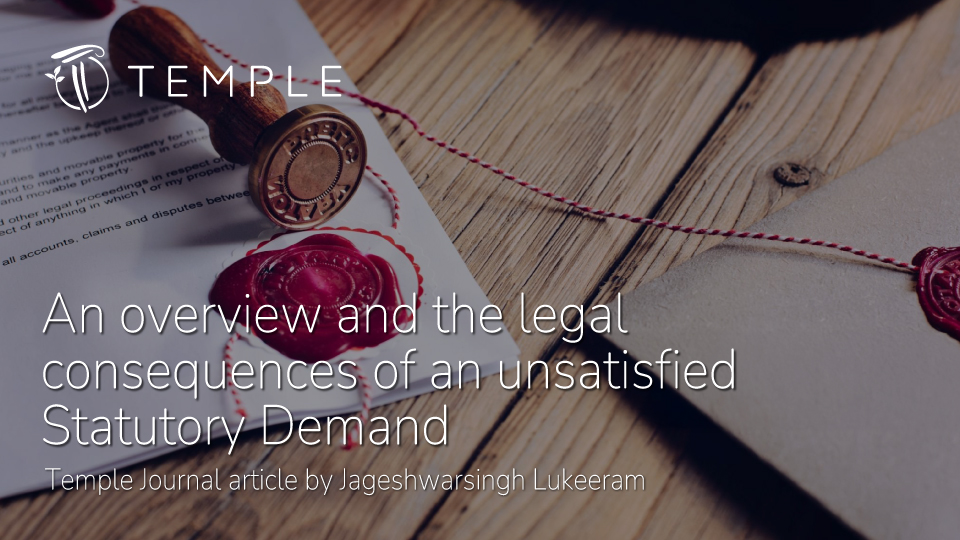Statutory demand, what is it?
Debtors do not usually clear their debts as and when required. In such instances, creditors are often compelled to take various steps to recover their money. Among these measures is the procedure of serving statutory demands, which is somehow considered extra-judicial in the sense that it does not necessitate court involvement.
In Morgan Philipsmiddle East & Africa SAS v Apavou Immobilier Ltee [2022] SCJ 393, the Supreme Court defined a statutory demand as a formal demand for payment of a debt served by a creditor on its debtor in a standard and prescribed form under the Insolvency Act 2009 (the “IA 2009”).
A proper statutory demand is a serious legal document issued under Section 181 of the IA 2009. It is distinct in both form and content from a notice mise en demeure and should in no circumstances be taken lightly by a debtor, considering its significant legal consequences.
Is there a prescribed form for a statutory demand?
Indeed, the law prescribes a specific form for a statutory demand. According to the Insolvency (Prescribed Forms) Regulations 2012, a statutory demand must adhere to the form specified in its Fifth Schedule. Failure of the creditor to comply with by the prescribed form may result in the statutory demand being set aside, if the debtor petitions the Supreme Court to this effect.
However, in Swan General Ltd v Doorgesh Sharma Khirodhur [2023] SCJ 205, the Supreme Court clarified that a defect in a statutory demand is not necessarily fatal to its validity unless it causes substantial injustice to the debtor.
In this case, the absence of the notification clause of the debtor’s right to apply to the Supreme Court for an extension of time to comply with the statutory demand, contrary to the prescribed form, the Supreme Court held that this would have been fatal had the debtor decided to comply with the statutory demand and would not have been notified of the possibility of applying for an extension of time as laid down statutorily.
The service of a statutory demand triggers a one-month deadline for the debtor to comply with its exigencies. The debtor may also apply to the Bankruptcy Division of the Supreme Court for an extension of this deadline. Importantly, this one-month compliance period should not be confused with the 14-day timeframe to apply to have the statutory demand set aside.
What is the statutory minimum debt for a statutory demand?
Under the IA 2009, the statutory minimum debt required to serve a statutory demand was initially MUR 100,000. However, following the COVID-19 pandemic, this threshold was increased to MUR 250,000 to limit the influx of demands against financially distressed companies. Consequently, creditors cannot issue a statutory demand for debts below MUR 250,000.
Should statutory demands be served only on debtor companies?
Statutory demands under the IA 2009 can only be served on debtor companies. In the case of Société du Cephage v Travaux Techniques des Mascareignes [2016] SCJ 469, the Supreme Court held that serving a statutory demand on an unregistered entity, such as a société civile et particulière, was procedurally improper. The then Justice Angoh upheld the objection, ruling that the legal procedure adopted by the creditor was misconceived in law.
Is there a deadline to set aside a statutory demand?
For the debtor to move the Bankruptcy Division of the Supreme Court for the statutory demand be set aside, the IA 2009 stipulates that it must be made, and served on the creditor within 14 days of the date of service of the demand. Any failure to comply with the 14-day mandatory requirement would fatally compromise the debtor’s application.
In Compagnie Sucrière de Bel Ombre Ltd v Alliance Building Contractors Ltd [2016] SCJ 131, the trial Judge declined an application to set aside a statutory demand on the basis that it was made outside the mandatory delay imposed by the Section 181 (2) of the IA 2009. The said judgment was later upheld by the Court of Civil Appeal.
What are the grounds to set aside a statutory demand?
If you are a debtor having in hand a statutory demand, and you believe that the debt claimed therein is in genuine dispute whether or not the debt is due, or that you have a counterclaim, set-off or cross demand bringing the amount claimed in the demand less that the prescribed amount, or for any other grounds that you think the demand should be set aside, then it is open to you to go to the Supreme Court to have it set aside.
As you may have already noted by now, a statutory demand may be set aside on various grounds. These grounds are specifically stated in the IA 2009; however, they are not all-inclusive.
After a statutory demand is served, the debtor must file an application within 14 days of being served with the statutory demand. Since this is a significant issue that may result in the dissolution of your company, it is imperative that you take immediate action. You must seek legal advice as quickly as you can if you are unsure of what to do next.
What are the legal consequences of an unsatisfied statutory demand?
In the event the statutory demand is not met or set aside by the Supreme Court, it is most likely that the creditor will initiate a winding-up petition to have the affairs of the debtor wound up. This does not in any manner means that the creditor will proceed with a winding-up petition against a failing debtor.
Reason for this is that the debtor’s failure to comply with the requirements of the statutory demand makes room for a legal presumption, though rebuttable by the debtor, that it is insolvent i.e. the debtor is presumed to be unable to pay its debts as they become due in the ordinary course of business. This presumption, however, is time sensitive. It lasts for only one month following the statutory demand’s one-month compliance period.
Beyond this timeframe, evidence of failure to comply with the demand may no longer be admissible as proof of insolvency, although creditors can still use other means to demonstrate the debtor’s inability to pay its debts.
Legal disclaimers
Since the legislative frameworks are subject to change, the overall situation discussed in this article could alter at any time. Additionally, since circumstances of each debtor is different, an article like this one cannot provide you with all of your alternatives, and some of the possibilities covered here may not be applicable to you. You should not take anything you have read here as legal advice for this and other reasons. If anything mentioned above affects you, you should seek legal advice promptly tailored to your situation.
[This article is republished from the Temple Journal Second Edition.]


